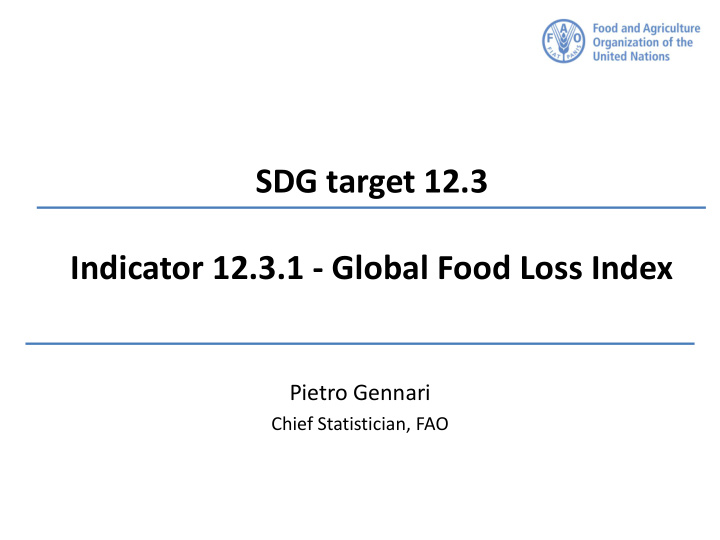



SDG target 12.3 Indicator 12.3.1 - Global Food Loss Index Pietro Gennari Chief Statistician, FAO
Target & Indicator • SDG Target 12.3 : “By 2030, halve per capita global food waste at the retail and consumer levels and reduce food losses along production and supply chains, including post- harvest losses” • Indicator 12.3.1 : Global Food Loss Index (GFLI), measuring the total losses of ag. commodities from the production to the retail level. • Limitations : – Incomplete coverage of the target : additional indicator of food waste (to be developed with EUROSTAT, WB, etc.) is needed – Model based as primary nationally representative data on losses are generally not available (4.4% official data reported yearly in FAOSTAT)
Indicator & Definition The Global Food Loss Index (GFLI) is calculated on a volume basis by commodity, by country, on an annual frequency. For each country (j) the loss index is calculated with the Laspeyres formula: Where: p i0 = 2004 -2006 average international price ($) for the commodity i q it = loss quantity (tons) for commodity i at time t q io = loss quantity (tons) for commodity i at the base period (2005) Change in food losses for country j over time: D j = [ ( FLI j, 2014 / FLI j, 2013 ) x 100 ] – 100
Why Tier III Indicator? • Reliable nationally representative data on losses are generally not available (4.4% official data reported yearly in FAOSTAT) – Mainly case studies based on expert opinions focused on few products or stages of the value chain • Lack of international guidelines on how to collect postharvest losses and waste data • Complexity of measurement : – Along different stages of the value chain (on farm-transport- storage-processing-distribution-household) – Different statistical units & survey tools – Value chain changing with different food products – Value chain changing in developing & developed countries
Coverage with Primary Data Proportion of data on losses collected from state agencies and publications (in %), 1990-2012
Current work on the indicator A two-pronged strategy 1. Develop food loss model – Model-based estimates as interim solution for global monitoring and for filling data gaps – Refine the model through case studies, empirical data and review by national and international experts (IAEG on Agricultural Statistics). 2. Develop cost-effective methods for collecting postharvest losses data and provide capacity development to countries to improve food loss measurement. • New guidelines & training materials being produced by the Global Strategy to Improve Agricultural Statistics • Technical assistance and training at regional and national levels
The model on Post-Harvest Losses • Hierarchical (4-level) linear model with country commodity-specific estimates at the lowest hierarchical level, followed by commodity-specific estimates, food group estimates, and finally perishable food group estimates. • Coefficients in the hierarchical model are estimated simultaneously to ensure they are consistent • Validation of the PHL estimates through the Food Balance Sheet accounting framework • Global reporting : estimates produced for 182 countries in the world for the period 1990-2013. (2014 estimates available before the end of 2016) • Possibility for countries to adapt the model to their data situation to produce national estimates, e.g. by adding variables on quality of the infrastructures & climatic conditions
Estimated Global Food Losses - 2013 Food losses in kcal, in % of supply
Guidelines: process Objective: • Support developing countries in producing nationally representative PHL estimates through a cost-effective data collection programme which focuses on the critical loss points Process : • Methodology developed by the Global Strategy to im; • Review process led by the IAEG on Agricultural Statistics. Members of the IAEG: – 12 Int. Organizations: Eurostat, ILO, SPC, UNESCAP, UNESCWA, UNECA, UNECLAC, UNICEF, UNSD, World Bank, WFP, WHO – 12 COUNTRIES = IBGE-Brazil, INEC-Colombia, INEI-Peru, ERS & NASS-USDA, PSA-Philippines, BPS-Indonesia, CSO-Myanmar, MoA-Morocco, CSA-Ethiopia, ZIMSTAT-Zimbabwe, IS-Albania, SBA-Sweden.
Guidelines: timeline 4 Reports produced so far (http://gsars.org/en/category/publications/technicalreports/) a. Review of Methods for Estimating Grain Post-Harvest Losses b. Synthesis of Methods & Techniques for assessing post-harvest losses c. Revised methodological and data collection options d. Field Test Protocol Field Testing in 3 countries - Malawi, Namibia & Ghana (April-July 2016): a. At farm-level b. At processing and storage level c. At wholesale market level Finalization of Guidelines and Data collection protocols by end 2016
Thank you for your attention Questions are most welcome!
Recommend
More recommend